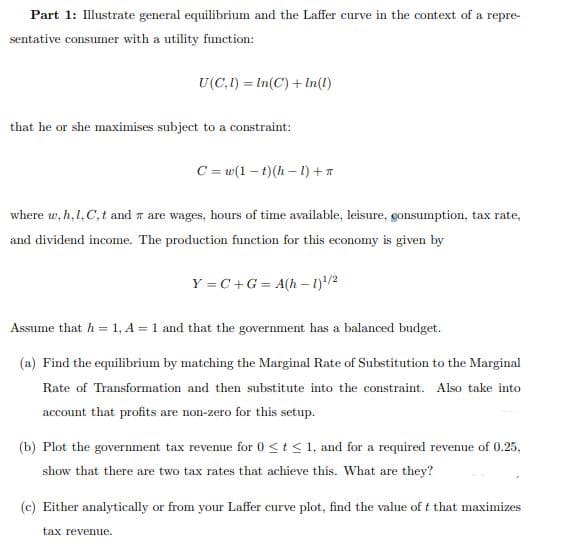Illustrate general equilibrium and the Laffer curve in the context of a repre- sentative consumer with a utility function: U(C,1) = In(C) + In(1) that he or she maximises subject to a constraint: C = w(1 - t)(h – 1) +* where w,h,l,C, t and a are wages, hours of time available, leisure, gonsumption, tax rate, and dividend income. The production function for this economy is given by Y = C+G = A(h – 1)/2
Illustrate general equilibrium and the Laffer curve in the context of a repre- sentative consumer with a utility function: U(C,1) = In(C) + In(1) that he or she maximises subject to a constraint: C = w(1 - t)(h – 1) +* where w,h,l,C, t and a are wages, hours of time available, leisure, gonsumption, tax rate, and dividend income. The production function for this economy is given by Y = C+G = A(h – 1)/2
Chapter21: Demand: Consumer Choic
Section: Chapter Questions
Problem 16E
Related questions
Question

Transcribed Image Text:Part 1: Illustrate general equilibrium and the Laffer curve in the context of a repre-
sentative consumer with a utility function:
U(C,1) = In(C) + In(1)
that he or she maximises subject to a constraint:
C= w(1- t)(h – 1) + *
where w, h,1, C, t and r are wages, hours of time available, leisure, eonsumption, tax rate,
and dividend income. The production function for this economy is given by
Y = C+G = A(h – 1)/2
Assume that h = 1, A = 1 and that the government has a balanced budget.
(a) Find the equilibrium by matching the Marginal Rate of Substitution to the Marginal
Rate of Transformation and then substitute into the constraint. Also take into
account that profits are non-zero for this setup.
(b) Plot the government tax revenue for 0 <t< 1, and for a required revenue of 0.25,
show that there are two tax rates that achieve this. What are they?
(c) Either analytically or from your Laffer curve plot, find the value of t that maximizes
tax revenue.
Expert Solution
This question has been solved!
Explore an expertly crafted, step-by-step solution for a thorough understanding of key concepts.
Step by step
Solved in 2 steps

Knowledge Booster
Learn more about
Need a deep-dive on the concept behind this application? Look no further. Learn more about this topic, economics and related others by exploring similar questions and additional content below.Recommended textbooks for you








Economics (MindTap Course List)
Economics
ISBN:
9781337617383
Author:
Roger A. Arnold
Publisher:
Cengage Learning
